귀, 코, 부비동, 인두, 아데노이드, 편도, 후두의 구조, Anatomy of the ears, nose, paranasal sinuses, pharynx, adenoids, tonsils, larynx and other
귀, 코, 부비동(부비강), 아데노이드 편도, 인두, 후두 등에 생긴 질환을 이비인후 질환이라고 한다.

사진 2. 정상 외이, 중이와 내이 그림
a- 외이도, b-고막, c-추골, d-중이(중이강), e-반규관(반고리관), f-침골, g-와우신경, h-이관 입구, i-안면신경(제 7뇌신경), k-전정, m-와우, n-이관(구씨관), o-등골, p-전정신경(전정와우신경/제 8뇌신경), r-경정맥, s-내경동맥, u-경돌상돌기
추골, 침골, 등골을 이소골이라고 한다.
Copyright ⓒ 2012 John Sangwon Lee, MD., FAAP
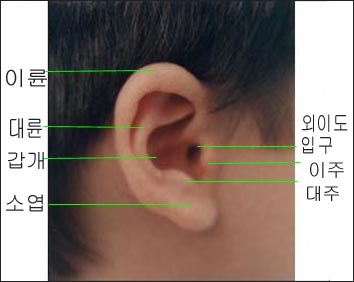
사진 1. 이개
Copyright ⓒ 2012 John Sangwon Lee, MD., FAAP
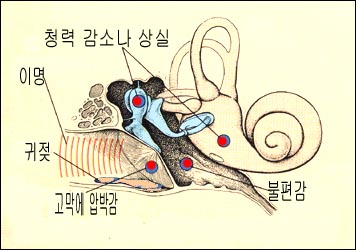
그림 172. 귀에 이런 증상과 징후가 있으면 중이나 내이에 생긴 병으로 어지러움 증이 생기는지 알아본다.
Differential diagnosis of Vertigo. Hospital Medicine. October 1970

그림 3. 와우(달팽이), 전정, 반고리관
a-와우, b-상반고리관, c-후부반고리관, d-외측반고리관, m-전정 창, n-와우 창, v-전정
출처; Gray anatomy
Copyright ⓒ 2012 John Sangwon Lee, MD., FAAP
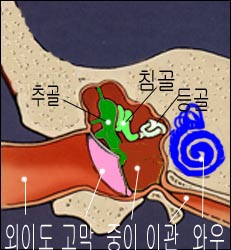
그림 4. 중이와 이소골(추골, 침골, 등골), 반고리관(와우)
Copyright ⓒ 2012 John Sangwon Lee, MD., FAAP
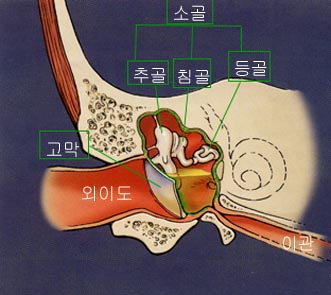
그림 5. 중이
Copyright ⓒ 2012 John Sangwon Lee, MD., FAAP
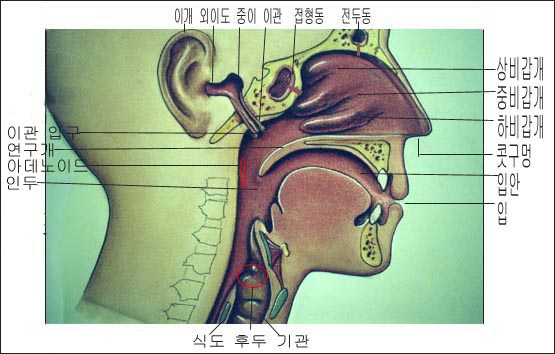
그림 8. 코, 인두, 후두
Copyright ⓒ 2012 John Sangwon Lee, MD., FAAP
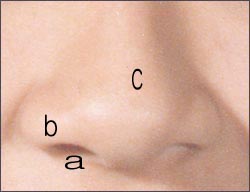
사진 6. 코
a-콧구멍, b-비익, c-콧등
Copyright ⓒ 2012 John Sangwon Lee, MD., FAAP

그림 7. a-비중격, b-비강
출처; Used with permission from Schering Corporation. Kenilworth, NJ와 소아가정간호백과

그림 12. a-아데노이드, b-인두의 후벽에 있는 림프조직, c- 편도, d-혀뿌리 부위에 있는 림프절 조직(설 편도)
Copyright ⓒ 2012 John Sangwon Lee, MD., FAAP

그림 13. 코, 입, 아데노이드, 편도
Copyright ⓒ 2012 John Sangwon Lee, MD., FAAP

그림 9. 비강 점막층 모세혈관
출처; Used with permission from Schering Corporation. Kenilworth, NJ와 소아가정간호백과
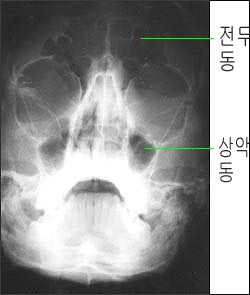
사진 11. 부비동 X-선 사진
전두동, 상악동
Copyright ⓒ 2012 John Sangwon Lee, MD., FAAP

사진 10. 부비동 X-선 사진
전두동, 사골동, 상악동
Copyright ⓒ 2012 John Sangwon Lee, MD., FAAP
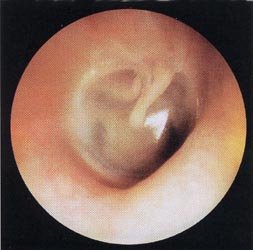
사진 16. 이경을 통해 육안으로 본 정상 고막 참조문헌18
출처; Otitis Media, Roche laboratories

사진 17. 급성 중이염이 있을 때 이경을 통해 육안으로 본 고막
고막이 팽만되고 발적되어 있다 참조문헌18
출처; Otitis Media, Roche laboratories
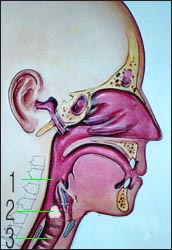
그림 14. 후두는 인두의 최하부와 기관의 최상부의 사이에 있다.
1-인두, 2-후두, 3-기도(기관).
Copyright ⓒ 2011 John Sangwon Lee, M.D., FAAP
그림 15.후두(후두경에 비친 부위가 후두이다)
a-후두개 b-진성성대 c-가성성대 d-성문. Use with permission from Schering Corporation. Kenilworth, NJ와 소아가정의학백과
Anatomy of the ears, nose, paranasal sinuses, pharynx, adenoids, tonsils, larynx and other
Diseases that occur in the ears, nose, sinuses (sinuses), adenoid tonsils, pharynx, and larynx are called otolaryngeal diseases.

Photo 2. Picture of normal outer, middle and inner ear a- external auditory canal, b-tympanum, c-vertebra, d-middle ear (middle ear cavity), e- semicircular canal (semicircular canal), f-incus, g-cochlear nerve, h- entrance to ear canal, i-facial nerve (7th cranial nerve), k-vestibular, m-cochlear, n-ear canal (bulbar canal), o-stapes, p-vestibular nerve (vestibular cochlear/eighth cranial nerve), r-jugular vein, s-internal carotid artery, u-carotid process The vertebrae, incus, and stapes are called ossicles. Copyright ⓒ 2012 John Sangwon Lee, MD., FAAP

Photo 1. Auricle Copyright ⓒ 2012 John Sangwon Lee, MD., FAAP

Figure 172. If you have these symptoms and signs in the ear, see if the dizziness is caused by a disease in the middle or inner ear. Differential diagnosis of Vertigo. Hospital Medicine. October 1970

Figure 3. Cochlea (snail), vestibule, and semicircular canals a-cochlear, b-superior semicircular canal, c-posterior semicircular canal, d-lateral semicircular canal, m-vesicular window, n-cochlear window, v-vestibular source; Gray anatomy Copyright ⓒ 2012 John Sangwon Lee, MD., FAAP

Figure 4. Middle ear and ossicles (vertebrae, incus, stapes) and semicircular canals (cochlear) Copyright ⓒ 2012 John Sangwon Lee, MD., FAAP

Figure 5. Middle ear Copyright ⓒ 2012 John Sangwon Lee, MD., FAAP

Figure 8. Nose, pharynx, and larynx Copyright ⓒ 2012 John Sangwon Lee, MD., FAAP

Photo 6. Nose a – nostrils, b – wings, c – bridges of the nose. Copyright ⓒ 2012 John Sangwon Lee, MD., FAAP

Figure 7. a – septum, b – nasal cavity source; Used with permission from Schering Corporation. Kenilworth, NJ and the Encyclopedia of Pediatric and Family Nursing

Figure 12. a-adenoids, b-lymphoid tissue in the posterior wall of the pharynx, c-tonsillery, d-lymph node tissue in the root of the tongue (lingual tonsil) Copyright ⓒ 2012 John Sangwon Lee, MD., FAAP

Figure 13. Nose, mouth, adenoids, and tonsils Copyright ⓒ 2012 John Sangwon Lee, MD., FAAP

Figure 9. Nasal mucosal capillaries source; Used with permission from Schering Corporation. Kenilworth, NJ and the Encyclopedia of Pediatric and Family Nursing

Picture 11. X-ray of the sinuses frontal sinuses, maxillary sinuses Copyright ⓒ 2012 John Sangwon Lee, MD., FAAP

Picture 10. X-ray of the sinuses fronto-dong, ethmoid, maxillary-dong Copyright ⓒ 2012 John Sangwon Lee, MD., FAAP

Photo 16. Normal tympanic membrane seen through the otoscope Reference 18 source; Otitis Media, Roche laboratories

Photo 17. The tympanic membrane seen through the otoscope in acute otitis media The eardrum is distended and red. Reference 18 source; Otitis Media, Roche laboratories

Figure 14. The larynx is located between the bottom of the pharynx and the top of the trachea. 1 – pharynx, 2 – larynx, 3 – airway (trachea). Copyright ⓒ 2011 John Sangwon Lee, M.D., FAAP
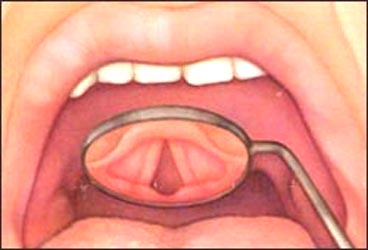
Figure 15. Larynx (The part reflected in the laryngoscope is the larynx) a – epiglottis b – true vocal cords c – false vocal cords d – glottis. Use with permission from Schering Corporation. Kenilworth, NJ and the Encyclopedia of Pediatric and Family Medicine
출처 및 참조 문헌 Sources and references
- NelsonTextbook of Pediatrics 22ND Ed
- The Harriet Lane Handbook 22ND Ed
- Growth and development of the children
- Red Book 32nd Ed 2021-2024
- Neonatal Resuscitation, American Academy of Pediatrics
- www.drleepediatrics.com 제1권 소아청소년 응급 의료
- www.drleepediatrics.com 제2권 소아청소년 예방
- www.drleepediatrics.com 제3권 소아청소년 성장 발육 육아
- www.drleepediatrics.com 제4권 모유,모유수유, 이유
- www.drleepediatrics.com 제5권 인공영양, 우유, 이유식, 비타민, 미네랄, 단백질, 탄수화물, 지방
- www.drleepediatrics.com 제6권 신생아 성장 발육 육아 질병
- www.drleepediatrics.com제7권 소아청소년 감염병
- www.drleepediatrics.com제8권 소아청소년 호흡기 질환
- www.drleepediatrics.com제9권 소아청소년 소화기 질환
- www.drleepediatrics.com제10권. 소아청소년 신장 비뇨 생식기 질환
- www.drleepediatrics.com제11권. 소아청소년 심장 혈관계 질환
- www.drleepediatrics.com제12권. 소아청소년 신경 정신 질환, 행동 수면 문제
- www.drleepediatrics.com제13권. 소아청소년 혈액, 림프, 종양 질환
- www.drleepediatrics.com제14권. 소아청소년 내분비, 유전, 염색체, 대사, 희귀병
- www.drleepediatrics.com제15권. 소아청소년 알레르기, 자가 면역질환
- www.drleepediatrics.com제16권. 소아청소년 정형외과 질환
- www.drleepediatrics.com제17권. 소아청소년 피부 질환
- www.drleepediatrics.com제18권. 소아청소년 이비인후(귀 코 인두 후두) 질환
- www.drleepediatrics.com제19권. 소아청소년 안과 (눈)질환
- www.drleepediatrics.com 제20권 소아청소년 이 (치아)질환
- www.drleepediatrics.com 제21권 소아청소년 가정 학교 간호
- www.drleepediatrics.com 제22권 아들 딸 이렇게 사랑해 키우세요
- www.drleepediatrics.com 제23권 사춘기 아이들의 성장 발육 질병
- www.drleepediatrics.com 제24권 소아청소년 성교육
- www.drleepediatrics.com 제25권 임신, 분만, 출산, 신생아 돌보기
- Red book 29th-31st edition 2021
- Nelson Text Book of Pediatrics 19th- 21st Edition
- The Johns Hopkins Hospital, The Harriet Lane Handbook, 22nd edition
- 응급환자관리 정담미디어
- Pediatric Nutritional Handbook American Academy of Pediatrics
- 소아가정간호백과–부모도 반의사가 되어야 한다, 이상원 저
- The pregnancy Bible. By Joan stone, MD. Keith Eddleman, MD
- Neonatology Jeffrey J. Pomerance, C. Joan Richardson
- Preparation for Birth. Beverly Savage and Dianna Smith
- 임신에서 신생아 돌보기까지. 이상원
- Breastfeeding. by Ruth Lawrence and Robert Lawrence
- Sources and references on Growth, Development, Cares, and Diseases of Newborn Infants
- Emergency Medical Service for Children, By Ross Lab. May 1989. p.10
- Emergency care, Harvey Grant and Robert Murray
- Emergency Care Transportation of Sick and Injured American Academy of Orthopaedic Surgeons
- Emergency Pediatrics A Guide to Ambulatory Care, Roger M. Barkin, Peter Rosen
- Quick Reference To Pediatric Emergencies, Delmer J. Pascoe, M.D., Moses Grossman, M.D. with 26 contributors
- Neonatal resuscitation Ameican academy of pediatrics
- Pediatric Nutritional Handbook American Academy of Pediatrics
- Pediatric Resuscitation Pediatric Clinics of North America, Stephen M. Schexnayder, M.D.
-
Pediatric Critical Care, Pediatric Clinics of North America, James P. Orlowski, M.D.
-
Preparation for Birth. Beverly Savage and Dianna Smith
-
Infectious disease of children, Saul Krugman, Samuel L Katz, Ann A.
- 제4권 모유, 모유수유, 이유 참조문헌 및 출처
- 제5권 인공영양, 우유, 이유, 비타민, 단백질, 지방 탄수 화물 참조문헌 및 출처
- 제6권 신생아 성장발육 양호 질병 참조문헌 및 출처
- 소아과학 대한교과서
-
제18권 소아청소년 이비인후과 질환 참조문헌 및 출처
-
Emergency Care Transportation of Sick and Injured American Academy of Orthopaedic Surgeons
-
Emergency Pediatrics A Guide to Ambulatory Care, Roger M. Barkin, Peter Rosen
-
Gray’s Anatomy
-
Habilitation of The handicapped Child, The Pediatric Clinics of North America, Robert H Haslam, MD.,
-
Pediatric Otolaryngology Sylvan Stool
-
Hearing Loss In children, The Pediatric Clinics of North America Nancy Roizen,MD and Allan O Diefendorf, PhD
-
Recent Advances in Pediatric otolaryngology The Pediatric Clinics of North America
-
Pediatric Otolaryngology. The Pediatric Clinics of North America, David Tunkel, MD., Kenneth MD Grundfast, MD
|
Copyright ⓒ 2015 John Sangwon Lee, MD., FAAP 미국 소아과 전문의, 한국 소아청소년과 전문의 이상원 저“부모도 반의사가 되어야 한다”-내용은 여러분들의 의사로부터 얻은 정보와 진료를 대신할 수 없습니다. “The information contained in this publication should not be used as a substitute for the medical care and advice of your doctor. There may be variations in treatment that your doctor may recommend based on individual facts and circumstances. “Parental education is the best medicine.” |